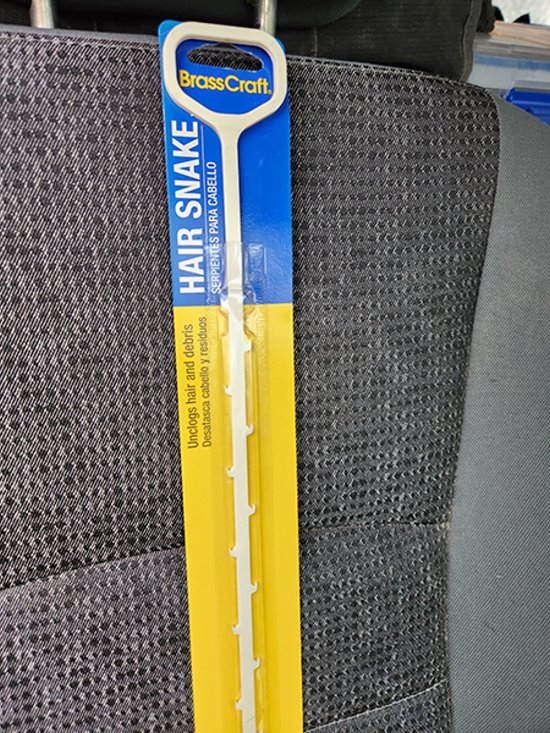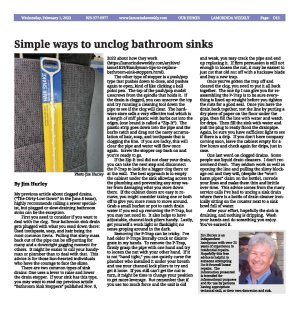| | Published February 1st, 2023
| Simple ways to unclog bathroom sinks
| | | By Jim Hurley |  | | Photo Jim Hurley |
My previous article about clogged drains, ("The-Dirty-Low-Down" in the June 8 issue), highly recommends calling a sewer specialist, but plugged or slow-draining bathroom sinks can be the exception.
 First you need to consider if you want to deal with the clog. Your bathroom sink drain gets plugged with what you send down there: Used toothpaste, soap, and hair being the most common items. Pulling that slimy mass back out of the pipe can be off-putting for many and a downright gagging moment for others. It might be easier to call your handyman or plumber than to deal with that. This advice is for those lion-hearted individuals who have the courage to face the slime.
First you need to consider if you want to deal with the clog. Your bathroom sink drain gets plugged with what you send down there: Used toothpaste, soap, and hair being the most common items. Pulling that slimy mass back out of the pipe can be off-putting for many and a downright gagging moment for others. It might be easier to call your handyman or plumber than to deal with that. This advice is for those lion-hearted individuals who have the courage to face the slime.
 There are two common types of sink drains: One uses a lever to raise and lower the drain stopper. If your sink has this type, you may want to read my previous article "Bathroom Sink Stoppers" published Nov. 9, 2022 about how they work (https://lamorindaweekly.com/archive/
There are two common types of sink drains: One uses a lever to raise and lower the drain stopper. If your sink has this type, you may want to read my previous article "Bathroom Sink Stoppers" published Nov. 9, 2022 about how they work (https://lamorindaweekly.com/archive/
 issue1619/Handyman-tips-to-replace-bathroom-sink-stoppers.html).
issue1619/Handyman-tips-to-replace-bathroom-sink-stoppers.html).
 The other type of stopper is a push/pop type that pushes down to close, and pushes again to open, kind of like clicking a ball point pen. The top of the push/pop model unscrews from the spindle that holds it. If the drain is clogged, you can unscrew the top and try running a cleaning tool down the pipe to see if the clog will clear. The hardware store sells a very effective tool which is a length of stiff plastic with barbs cut into the edges, (one brand is called a "Zip-It"). The plastic strip goes down into the pipe and the barbs catch and drag out the nasty accumulation of hair, soap, and toothpaste that is clogging the line. If you are lucky, this will clear the pipe and water will flow once again. Screw the stopper cap back on and you're ready to go.
The other type of stopper is a push/pop type that pushes down to close, and pushes again to open, kind of like clicking a ball point pen. The top of the push/pop model unscrews from the spindle that holds it. If the drain is clogged, you can unscrew the top and try running a cleaning tool down the pipe to see if the clog will clear. The hardware store sells a very effective tool which is a length of stiff plastic with barbs cut into the edges, (one brand is called a "Zip-It"). The plastic strip goes down into the pipe and the barbs catch and drag out the nasty accumulation of hair, soap, and toothpaste that is clogging the line. If you are lucky, this will clear the pipe and water will flow once again. Screw the stopper cap back on and you're ready to go.
 If the Zip-It tool did not clear your drain, you can take the next step and disconnect the P-Trap to look for a bigger clog there or at the wall. The best approach is to empty the cabinet under the sink allowing access to the plumbing and preventing any stray water from damaging what you store down there. If the cabinet doors are easy to remove, you might consider taking one or both off to give you more room to move around. Grab a small bucket or pot to catch drain water if you end up removing the P-Trap, but you may not need to. It also helps to have adjustable, channel-lock pliers handy. Lastly, get yourself a work light or flashlight; no sense groping around in the dark.
If the Zip-It tool did not clear your drain, you can take the next step and disconnect the P-Trap to look for a bigger clog there or at the wall. The best approach is to empty the cabinet under the sink allowing access to the plumbing and preventing any stray water from damaging what you store down there. If the cabinet doors are easy to remove, you might consider taking one or both off to give you more room to move around. Grab a small bucket or pot to catch drain water if you end up removing the P-Trap, but you may not need to. It also helps to have adjustable, channel-lock pliers handy. Lastly, get yourself a work light or flashlight; no sense groping around in the dark.
 Removing the P-Trap can be tricky. I've had older P-Traps literally crack or disintegrate in my hands. To remove the P-Trap, firmly grasp the pipe with one hand and try to loosen the nut with your other hand. If it is not "hand tight," you can quietly curse the plumber who installed it under your breath and use your channel lock pliers to try and get it loose. If you still can't get the nut to turn, it might be time to change your position to get more leverage. But remember that if you use too much force and the unit is old and weak, you may crack the pipe and end up replacing it. If firm persuasion is still not enough to loosen the nut, it may be easiest to just cut that old nut off with a hacksaw blade and buy a new trap.
Removing the P-Trap can be tricky. I've had older P-Traps literally crack or disintegrate in my hands. To remove the P-Trap, firmly grasp the pipe with one hand and try to loosen the nut with your other hand. If it is not "hand tight," you can quietly curse the plumber who installed it under your breath and use your channel lock pliers to try and get it loose. If you still can't get the nut to turn, it might be time to change your position to get more leverage. But remember that if you use too much force and the unit is old and weak, you may crack the pipe and end up replacing it. If firm persuasion is still not enough to loosen the nut, it may be easiest to just cut that old nut off with a hacksaw blade and buy a new trap.
 Once you've gotten the trap off and cleared the clog, you need to put it all back together. The one tip I can give you for reassembling the P-Trap is to be sure everything is lined up straight before you tighten the nuts for a good seal. Once you have the drain back together, test the line by putting a dry piece of paper on the floor under the pipe, then fill the line with water and watch for drips. Then fill the sink with water and pull the plug to really flood the drainpipe. Again, be sure you have sufficient light to see if there is a drip. If you don't have company coming soon, leave the cabinet empty for a few hours and check again for drips, just in case.
Once you've gotten the trap off and cleared the clog, you need to put it all back together. The one tip I can give you for reassembling the P-Trap is to be sure everything is lined up straight before you tighten the nuts for a good seal. Once you have the drain back together, test the line by putting a dry piece of paper on the floor under the pipe, then fill the line with water and watch for drips. Then fill the sink with water and pull the plug to really flood the drainpipe. Again, be sure you have sufficient light to see if there is a drip. If you don't have company coming soon, leave the cabinet empty for a few hours and check again for drips, just in case.
 One last word on clogged drains. Some people use liquid drain cleaners. I don't recommend them. They seldom work as well as opening the line and pulling the slimy blockage out and they will, (despite the "won't harm pipes" claim on the bottle), corrode your lines and make them thin and brittle over time. This advice comes from the many service calls I've had to unclog a sink drain where there is a bottle of drain-cleaner ironically sitting on the counter next to a sink bowl full of water.
One last word on clogged drains. Some people use liquid drain cleaners. I don't recommend them. They seldom work as well as opening the line and pulling the slimy blockage out and they will, (despite the "won't harm pipes" claim on the bottle), corrode your lines and make them thin and brittle over time. This advice comes from the many service calls I've had to unclog a sink drain where there is a bottle of drain-cleaner ironically sitting on the counter next to a sink bowl full of water.
 After your effort, hopefully the sink is draining, and nothing is dripping. Wash your hands and do something you enjoy. You've earned it.
After your effort, hopefully the sink is draining, and nothing is dripping. Wash your hands and do something you enjoy. You've earned it. |
 | | Jim Hurley is an independent handyman with over 25 years of experience in residential repairs. Hopefully this free advice is helpful to someone attempting Do-It-Yourself home repairs. The information presented is intended for informational purposes and for use by persons having appropriate technical skill, at their own discretion and risk. | | | | | | | | | | | |




